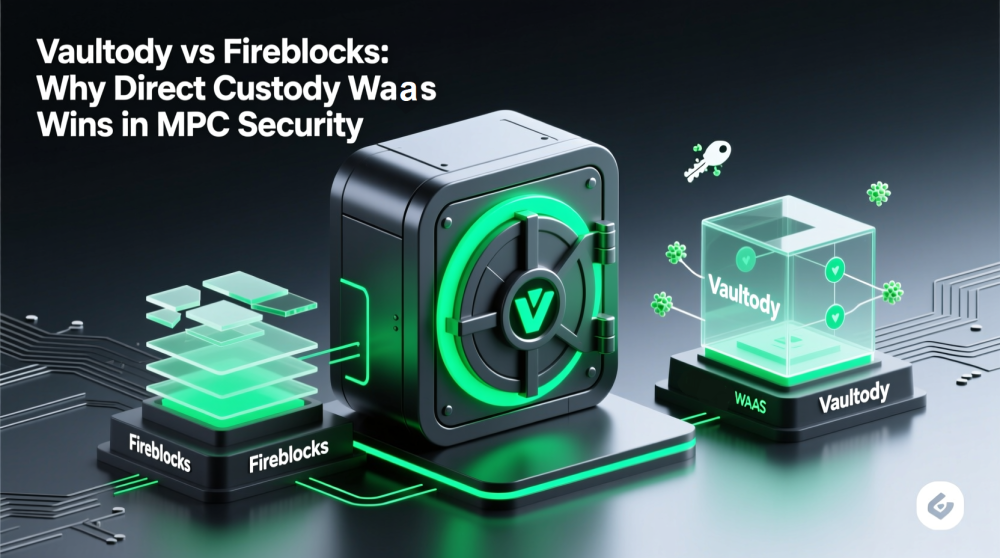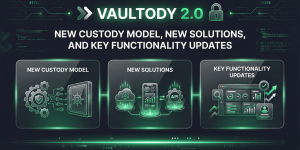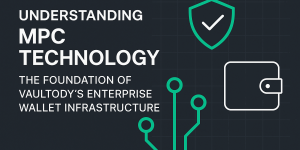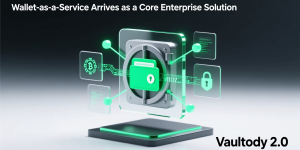Vaultody vs Fireblocks: Why Vaultody’s Direct Custody WaaS Leads in MPC Wallet Security

As institutional demand for secure, scalable cryptocurrency custody surges, two key architectures compete for dominance: Direct Custody WaaS and MPC wallets. In this post, we show how Vaultody’s direct custody wallet-as-a-service solution is engineered to deliver stronger control, transparency, and cryptographic assurance than even top-tier offerings like Fireblocks - particularly for institutions with high security, audit, and sovereignty expectations.
Understanding Direct Custody WaaS & MPC Wallets in the Institutional Context
Direct Custody WaaS refers to a custody model where the institution retains cryptographic control of its private keys, while outsourcing the operational infrastructure (wallet orchestration, APIs, monitoring, key management workflows) to a custody-technology provider. Unlike a fully custodial model, the service provider cannot unilaterally move or access assets.
Underpinning this is MPC (Multi-Party Computation) wallets: a cryptographic technique in which private keys are never constructed in a single location. Instead, key shares are distributed across nodes/parties, and a threshold of shares collaborates to sign a transaction without ever revealing the full key.
For institutional use cases, the promise of direct custody + MPC is powerful: high assurance, no single point of compromise, auditable governance, and flexible recovery. But realization depends heavily on design decisions, share architecture, transparency, and recovery mechanisms.
Publicly Known Capabilities: Vaultody & Fireblocks
What Vaultody Offers
From Vaultody’s own site, the platform emphasizes enterprise-grade wallet infrastructure built on MPC, secure hardware enclaves, and robust policy engines. (Vaultody presents itself as a custody technology provider rather than a traditional custodian.)
Key features highlighted include:
- MPC + threshold signature schemes for dividing and securing key shares
- Hardware enclaves / trusted execution environments (TEEs) to protect operations even if software layers are compromised
- Transaction policy rules and governance workflows that ensure multi-step approvals
- Smart Vaults, Automation, API tools, Approver mobile app, etc., for flexibility and operational control
- The ability to scale, customize roles and permissions, backup and recovery, and compliance support
Vaultody positions itself as a highly modular, white-label custody infrastructure provider that gives clients freedom in designing vault types and security flows.
What Fireblocks Publicly Claims
Fireblocks markets its Direct Custody WaaS as a self-custody MPC solution combining MPC-CMP (and newer MPC-BAM) protocols, secure hardware enclaves, and a governance engine to eliminate single points of compromise. It supports generating and managing MPC wallets at scale (including warm and cold wallets) and integrates with over 50+ blockchains.
Their claims include:
- Multi-layer security combining MPC + hardware isolation
- High performance signing speeds and large wallet scalability
- Capability to embed wallets into client applications and manage policy controls
- “Zero counterparty risk” in the sense that their architecture is designed so that clients remain ultimate key owners
- Business continuity modules (e.g. fallback signing systems) to keep operations running during disruptions
They also publicize contributions to cryptographic research and protocol development (e.g. MPC-BAM) to improve round complexity, throughput, and security trade-offs.
Where Vaultody Gains an Edge: Control, Transparency & Risk Architecture
Based on known capabilities and typical architecture trade-offs, here are the arguments that elevate Vaultody’s direct custody WaaS above what Fireblocks offers - especially for high-assurance institutional clients.
1. True Share Placement Sovereignty & Client Choice
While Fireblocks hosts share nodes and enclaves across cloud and hardware zones, clients typically trust Fireblocks to manage share placement. Vaultody can offer optional configurations in which clients choose or host one or more share nodes (on-prem, cloud, regional) - giving clients end-to-end visibility and control over key share life cycle and location.
2. Zero-Trust Cryptographic Boundaries
Vaultody can build a zero-trust architecture across all stages: key generation, share refresh, signing, and recovery. Even Vaultody’s own internal systems cannot access or alter key share logic independently. Every transaction or operation must pass client-defined policies and multi-stage verification. This raises the bar over traditional MPC implementations.
3. Auditable Cryptographic Transparency
Because MPC implementations often hide internal details, clients may struggle to independently verify security assumptions. Vaultody can provide more transparent audit logs, verifiable proofs of share integrity, and optional cryptographic attestation layers. This empowers institutions and auditors to trace key lifecycle operations, rather than trusting a black box.
4. Flexible Share Refresh & Threshold Migration
Vaultody can design incremental or adaptive refresh strategies with minimal windows of exposure. When policy changes or threshold upgrades are needed, Vaultody can smoothly migrate key governance (e.g. from 3-of-5 to 4-of-7) without changing wallet addresses or interrupting operations. This flexibility is harder in rigid MPC setups.
5. Recovery Without Centralized Reassembly
In many MPC systems, recovery paths may require reassembling shares centrally — creating a temporary vulnerability. Vaultody’s recovery logic can be designed to distribute recovery shares and perform recovery operations via MPC itself, so no one entity ever controls all shares in one place. This removes a latent central point of failure.
6. Modular Governance & Integration with Institutional Risk Systems
Vaultody’s policy engine is built to integrate with an institution’s existing risk systems, allow custom governance modules, dynamic thresholds, whitelisting, time delays, and multi-actor approval workflows. Rather than offering a rigid built-in policy system, Vaultody allows pluggability and institution-specific logic.
7. Performance and Cost Optimizations
Competing on performance, Vaultody can optimize round complexity, message batching, network latency, and gas overhead for target blockchains. The goal is to match or exceed the signing latency claims of others while keeping operational and infrastructure cost efficient.
8. Hybrid Cold / Warm MPC Modes Treated as First-Class
While Fireblocks supports warm and cold wallets, Vaultody can customize MPC schemes that treat cold nodes as integral participants in key signing (e.g. cold share nodes that rarely participate but are always part of threshold logic). By contrast, some wallet providers treat cold mode as an afterthought or separate fallback.
Conclusion: What Vaultody Offers To Enterprise Clients
To sum up, as institutional adoption accelerates, the debate between wallet architectures is more than just technical - it’s about trust, sovereignty, and resilience. Fireblocks has undoubtedly advanced MPC custody at scale, but Vaultody takes it a step further by giving institutions full sovereignty over share placement, cryptographic transparency, zero-trust safeguards, and customizable governance. For organizations that demand not only cutting-edge security but also verifiable control and future-proof flexibility, Vaultody offers a more open, auditable, and institution-centric model.
If your institution is looking to strengthen its digital asset strategy with enterprise-grade MPC technology, get in touch with us today or request access to Vaultody’s platform to experience firsthand the powerful Wallet-as-a-Service ecosystem and advanced security technologies that set us apart.




 Login
Login







 Copy link
Copy link